
This resource will enable students to determine flawed reasoning in a fraction comparison with unlike numerators and denominators.
- Subject:
- Mathematics
- Material Type:
- Activity/Lab
- Assessment
- Lesson
- Date Added:
- 07/18/2018

This resource will enable students to determine flawed reasoning in a fraction comparison with unlike numerators and denominators.
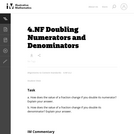
This is a task from the Illustrative Mathematics website that is one part of a complete illustration of the standard to which it is aligned. Each task has at least one solution and some commentary that addresses important asects of the task and its potential use. Here are the first few lines of the commentary for this task: How does the value of a fraction change if you double its numerator? Explain your answer. How does the value of a fraction change if you double its den...

Add and Subtract Fractions with Different Denominators.

In this video segment from Cyberchase, the CyberSquad must locate a crystal with the highest fraction of orange color.
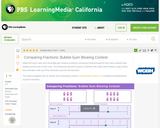
In this interactive activity adapted from Anneberg Learner’s Teaching Math Grades 3–5, compare fractions on number lines to determine which class of students wins bubble-gum-blowing contests.

This lesson focuses on comparing and ordering fractions in ways that encourage deeper understanding of’ ‘number sense’ by supporting learners to consider different techniques to order and compare fractions with different numerators and denominators. The three techniques covered in this lesson are those used to compare fractions with like numerators or denominators, unlike numerators or denominators and by comparing to a 1/2 benchmark. Emphasis are placed on the two latter techniques. Activities and practice exercises involve real-world problems including sales discounts, cooking measurements and school score reports.

In this Cyberchase video segment, Shari Spotter gets help from the CyberSquad in doubling a recipe for crumpets.
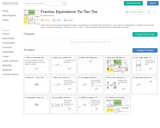
Show what you know about equivalent fractions and ordering by choosing three activities (in a row, column, or diagonal) to complete the tic-tac-toe board. Standards assessed: 3.NF.3a-d, 4.NF.1, 4.NF.2. This assessment was designed for adult basic education.
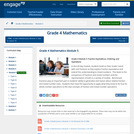
In this 40-day module, students build on their Grade 3 work with unit fractions as they explore fraction equivalence and extend this understanding to mixed numbers. This leads to the comparison of fractions and mixed numbers and the representation of both in a variety of models. Benchmark fractions play an important part in students ability to generalize and reason about relative fraction and mixed number sizes. Students then have the opportunity to apply what they know to be true for whole number operations to the new concepts of fraction and mixed number operations.
Find the rest of the EngageNY Mathematics resources at https://archive.org/details/engageny-mathematics.
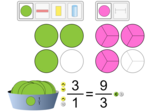
Build equivalent fractions with different denominators. Match shapes and numbers to earn stars in the game. Challenge yourself on any level you like. Try to collect lots of stars!

This is a challenging fraction comparison problem. The fractions for this task have been carefully chosen to encourage and reward different methods of comparison.
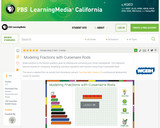
In this interactive activity adapted for grades 3–5 from Annenberg Learner’s Teaching Math Grades 6–8, use virtual Cuisenaire® Rods to represent fractions and to perform operations with fractions.

This task is designed to help students focus on the whole that a fraction refers to. It helps students to realize that two different fractions can describe the same situation depending on what you choose to be the whole.

(Nota: Esta es una traducción de un recurso educativo abierto creado por el Departamento de Educación del Estado de Nueva York (NYSED) como parte del proyecto "EngageNY" en 2013. Aunque el recurso real fue traducido por personas, la siguiente descripción se tradujo del inglés original usando Google Translate para ayudar a los usuarios potenciales a decidir si se adapta a sus necesidades y puede contener errores gramaticales o lingüísticos. La descripción original en inglés también se proporciona a continuación.)
En este módulo de 40 días, los estudiantes se basan en su trabajo de grado 3 con fracciones unitarias mientras exploran la equivalencia de fracción y extienden esta comprensión a números mixtos. Esto lleva a la comparación de fracciones y números mixtos y a la representación de ambos en una variedad de modelos. Las fracciones de referencia juegan un papel importante en la capacidad de los estudiantes para generalizar y razonar sobre la fracción relativa y los tamaños de números mixtos. Luego, los estudiantes tienen la oportunidad de aplicar lo que saben para ser cierto para las operaciones de números enteros a los nuevos conceptos de fracción y operaciones de números mixtos.
Encuentre el resto de los recursos matemáticos de Engageny en https://archive.org/details/engageny-mathematics.
English Description:
In this 40-day module, students build on their Grade 3 work with unit fractions as they explore fraction equivalence and extend this understanding to mixed numbers. This leads to the comparison of fractions and mixed numbers and the representation of both in a variety of models. Benchmark fractions play an important part in students ability to generalize and reason about relative fraction and mixed number sizes. Students then have the opportunity to apply what they know to be true for whole number operations to the new concepts of fraction and mixed number operations.
Find the rest of the EngageNY Mathematics resources at https://archive.org/details/engageny-mathematics.
![OREGON MATH STANDARDS (2021): [4.NF]](https://img.oercommons.org/160x134/oercommons/media/courseware/lesson/image/13138_ODE_Math_Logo_2018-H_color_BvjqVNy.png)
The intent of clarifying statements is to provide additional guidance for educators to communicate the intent of the standard to support the future development of curricular resources and assessments aligned to the 2021 math standards. Clarifying statements can be in the form of succinct sentences or paragraphs that attend to one of four types of clarifications: (1) Student Experiences; (2) Examples; (3) Boundaries; and (4) Connection to Math Practices.

This task provides a context where it is appropriate for students to subtract fractions with a common denominator; it could be used for either assessment or instructional purposes.

In this video segment from Cyberchase, Jackie and Inez figure out how to break an Electro-Root into 2/5, one of the ingredients for the antidote to Motherboardë_í__ virus.

In this video segment from Cyberchase, Matt and Digit divide up the healing stone and discover equivalent fractions.
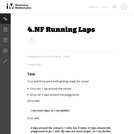
The purpose of this task is for students to compare two fractions that arise in a context. Because the fractions are equal, students need to be able to explain how they know that.

The goal of this task is to provide examples for comparing two fractions by finding a benchmark fraction which lies in between the two.